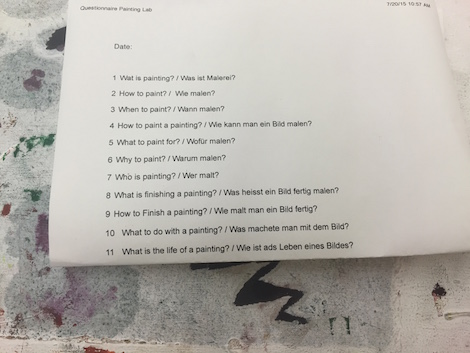| « 11 / 30 Grounded Lions | 9 / 30 Your layers of the real » |
10 / 30 Real Questions
“We like lists, because we don’t want to die.” (Umberto Eco)
To Umberto Eco lists are the origin of culture. It is the most common way of human beings to deal with an overwhelming reality. Whenever we are confronted with something infinite or incomprehensible, like death, we start lists to create order. Black lists, red lists, pink lists, green lists. From bucket list to playlist, from shopping list to legal text, lists have two functions: to order and to externalize an inner process of thought and thus make it manifest.

How does one cope with the infinite demands of creating something new? When I visit Varda Caivano’s class I am told that several lists have left their traces here. This was one of their first exercises. Each of the students was given a list of questions about painting that they had to answer for themselves. Later, they should write a list of questions on their own, collecting all questions that come to their mind during painting.
- What am I painting?
- Where is the focus?
- How do I balance the composition?
- Should I describe that more?
- What about the edges?
- Is there enough variation?
- How do I create space in the work?
- Should I put a line there?
- How do I finish the work?
- What does it need?
- How do I frame that piece?
- What am I communicating?
- How do I use a palette knife?
- How do I define what I am doing?
- What do the colors transmit?
- How does the work translate?
- What am I communicating?
A personal list from one of Varda Caivano’s students
What is the first thing you do when you meet a new class?
First you have to find out who your students are and what they need. What I did in the beginning with my class here is to hand out questionnaires, just to prepare them for these two weeks. Then they should develop their own questions. So instead of confronting me with their questions, they first confronted themselves. They were very basic questions like: what is a painting? What is painting for? What is the life of a work? The questions are resources for them. What I try to show them or help them to find out are things about themselves. And make them feel more confident as well. So it is about giving them both freedom and at the same time make them feel stronger as artists and basically tell them that they are artists.
Tell me more about this process.
Artists feel either really good or really bad about themselves, but there is neither a here or there. It is a process like doing research. There is a method and in certain moments you evaluate while in other moments you make. And then there is a lot of context, your personal and material context. These things are quite easy to quantify. It is not like ‘anything goes’. There are things that you can name. It is a little bit like in science: you can’t change everything at the same time. It is possible to talk about all these things and it is possible to organize even the things you don’t know and even the failures and the downs and the problems and to put them in a place and come back to them later.
Can you give me an example for these questions?
It’s often really pragmatic. If you don’t have a big studio and you don’t have a lot of money you paint small. You don’t think about big paintings then. With art many people get troubled. I want to give them resources for them to find out what they have and what they don’t have and what they need.
What did you do afterwards?
I divided them into different groups, so they can help each other. That means they realize that they have resources to look at the work of other people. And when they look at their own work in a small group their relationship with their work changes. Their thoughts become more objective and they can legitimate their own work better. I don’t really believe in teaching as such. So either we practice the really old fashioned way where you as a teacher give technical advice, which I think is very useful and important. But it is more important that they realize that they can go through that process also with other fellow artists. And the reality is that to some questions I don’t have an answer.I can’t tell you what painting is. The questions are just a resource.

